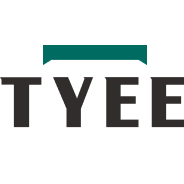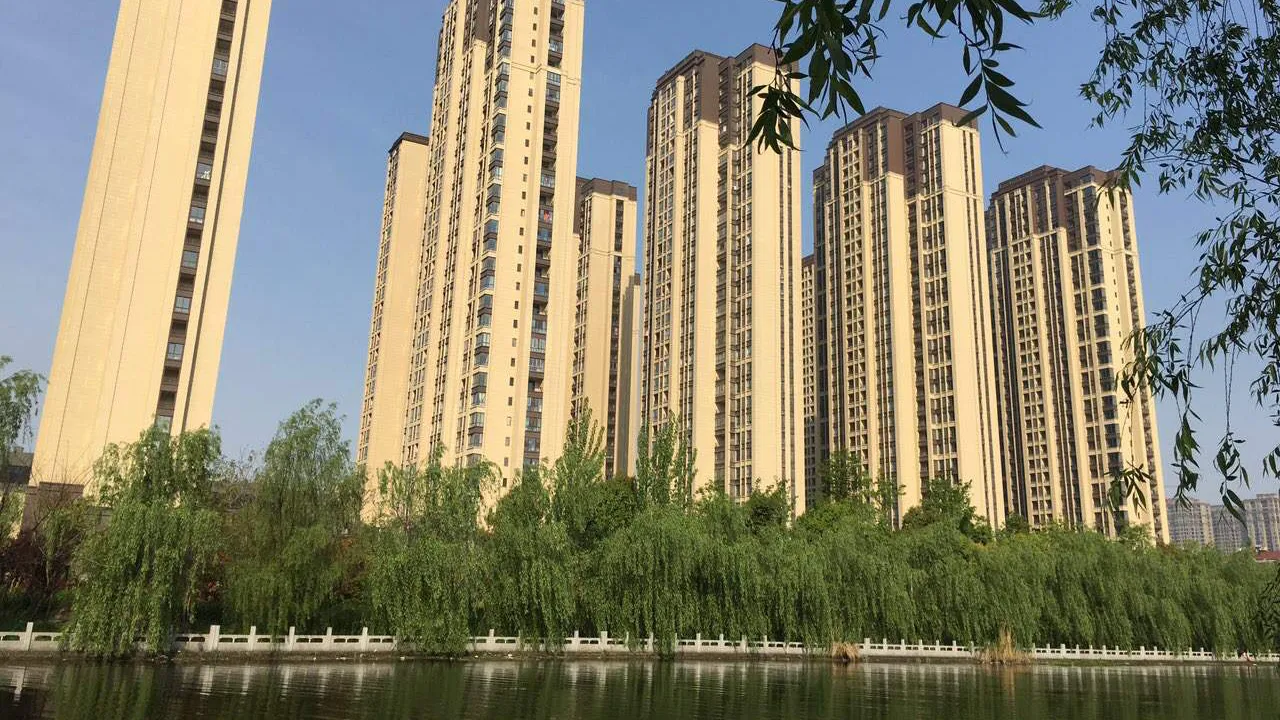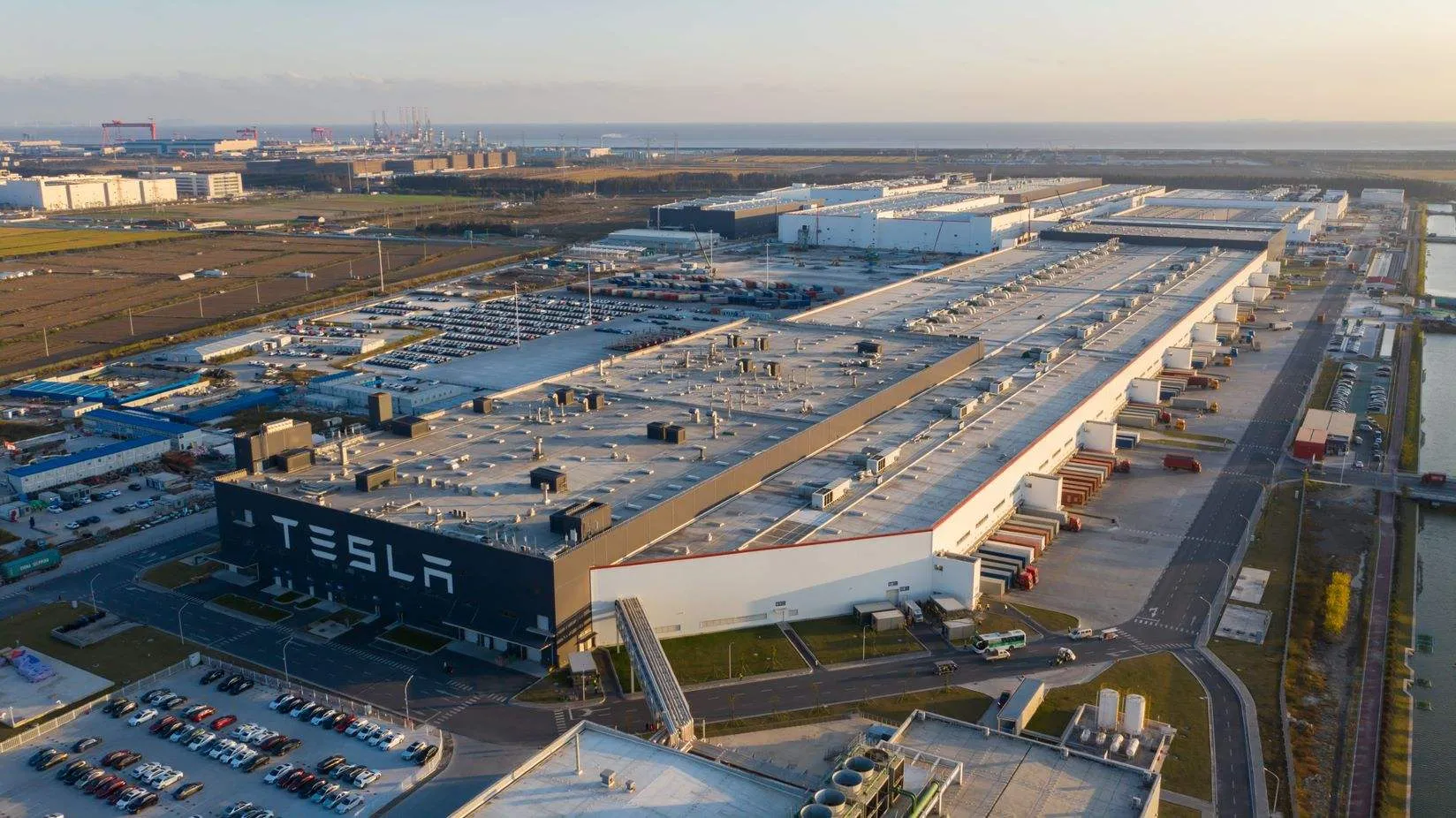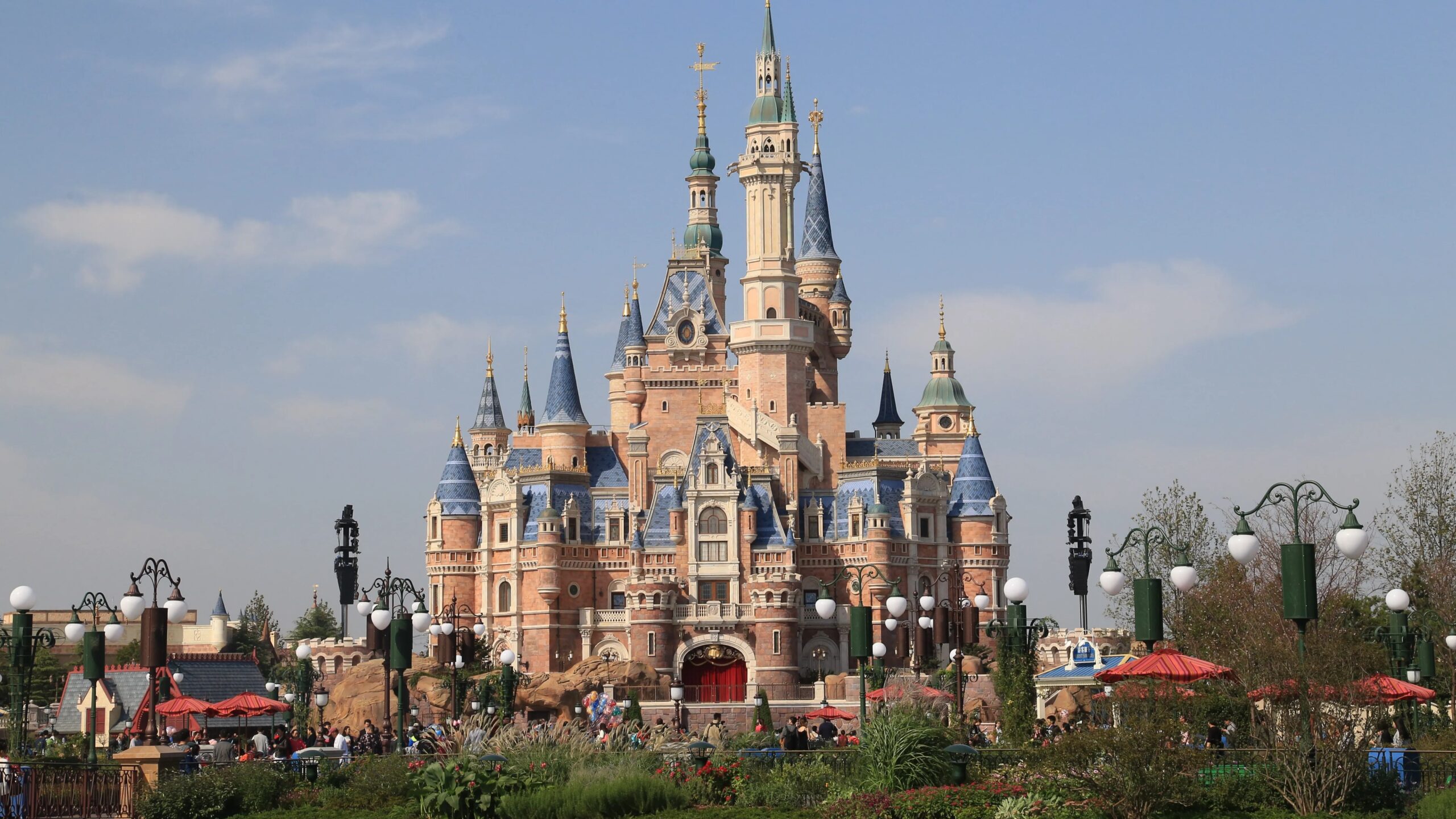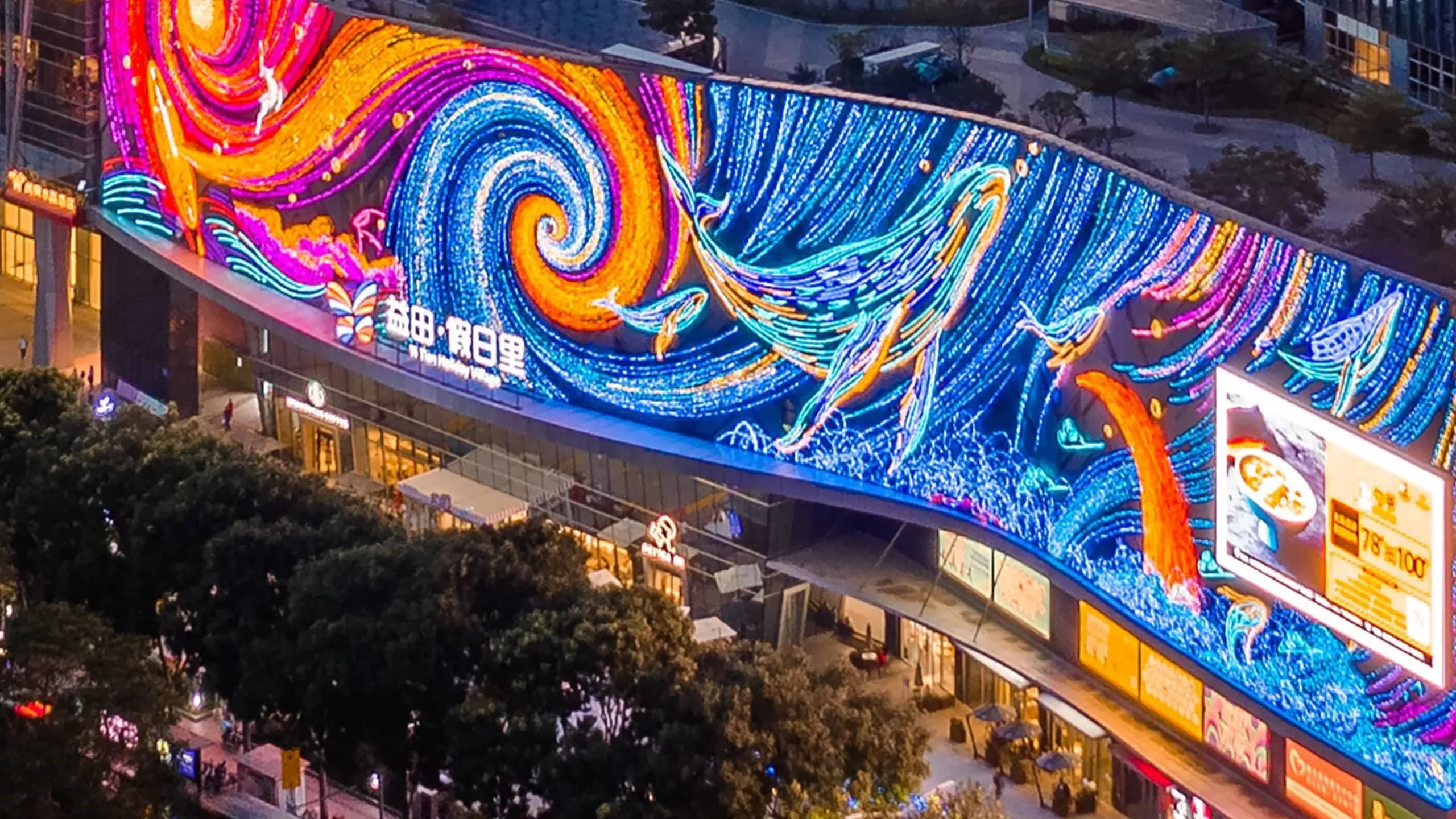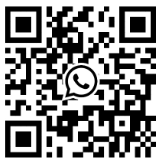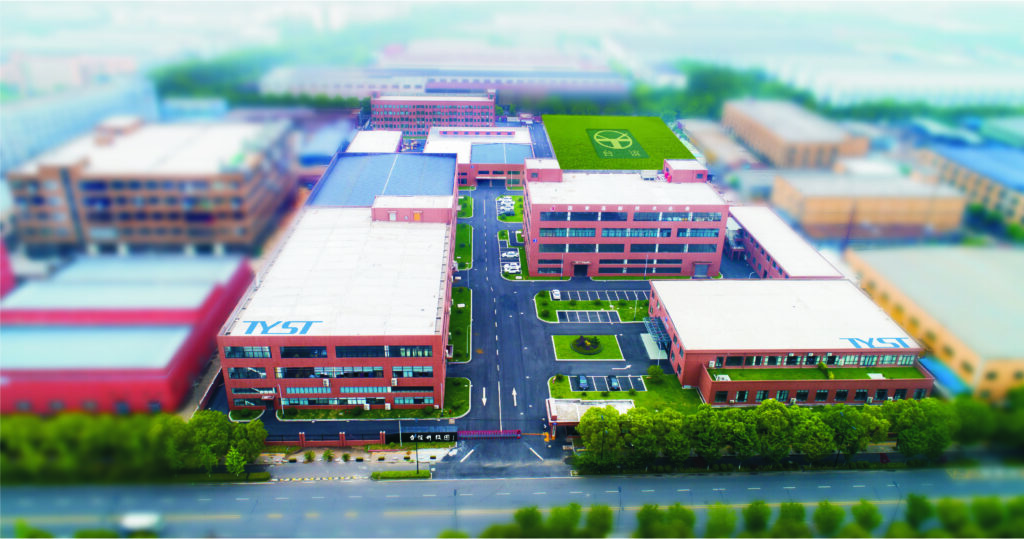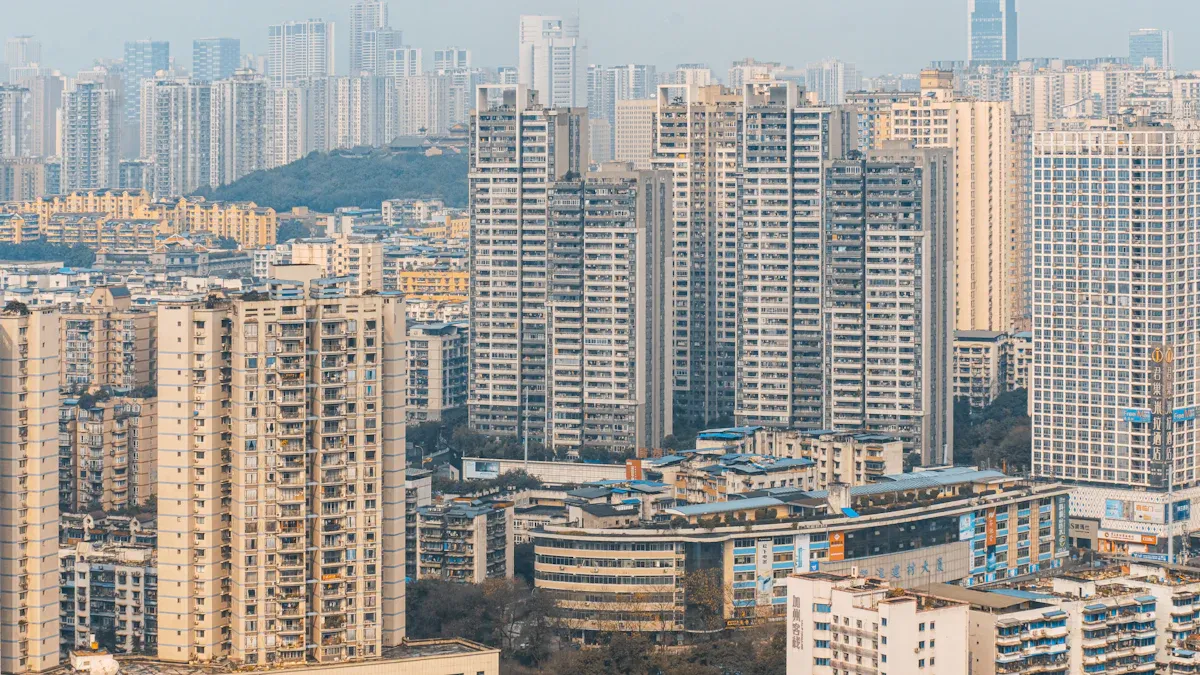
You can help build fire-resilient communities in the Philippines by supporting smart fire safety upgrades. Many people in the Philippines live in areas where fire risks are increasing every day. Urban renewal projects in the Philippines present opportunities for meaningful change. When you walk through crowded neighborhoods, you see the urgent need for improvement. By taking action, you contribute to creating fire-resilient communities. The Philippines requires stronger regulations, improved building standards, and innovative solutions to drive real progress.
Tip: Encourage others in the Philippines to participate in fire safety programs and help make fire-resilient communities a reality.
Key Takeaways
-
Making communities safe from fires needs good plans. It also needs strong laws. People, leaders, and experts must work together.
-
Smart fire safety tools like alarms help find fires early. Emergency lights and sensors help people get out fast and safe.
-
Fixing informal settlements with safer materials lowers fire risks. Better infrastructure and clear land rights help people respond to disasters.
-
Training the community and doing fire drills helps everyone get ready. Working together helps people act fast and stay safe in fires.
-
Always improving and using new technology helps communities stay safe. It helps protect people and their things from changing risks.
Building Fire-Resilient Communities
Integrated Safety Approaches
You can help make urban communities in the Philippines safer from fire by focusing on how people, systems, and policies work together. In dense renewal areas, disaster risk reduction requires more than new tools. It needs clear planning, stronger laws, and active participation from residents. When these parts align, communities become more resilient and prepared.
Here are the main parts of fire-resilient urban renewal areas:
-
Urban risk assessment. Identify major fire risks such as faulty electrical systems, old building materials, and narrow escape routes.
-
Upgrading infrastructure. Replace outdated wiring, improve water supply and hydrants, and add modern fire detection systems.
-
Safe building design. Use fire-resistant materials and follow updated building codes for renovations and new projects.
-
Clear evacuation routes. Plan open spaces, signage, and pathways that make evacuation faster in crowded areas.
-
Waste and combustible control. Reduce clutter, manage garbage, and prevent unsafe storage of flammable items.
-
Community education and drills. Train residents on fire response, evacuation, and safe daily practices.
-
Policy and enforcement. Strengthen land-use rules, enforce fire codes, and ensure compliance across all levels.
-
Collaboration. Work with local leaders, NGOs, and businesses to share resources and build stronger safety networks.
When these steps are applied, communities create lasting change. Experience from other cities shows that combining strong governance with active resident engagement reduces losses and increases safety. For the Philippines, this means not only fewer fire incidents but also more trust and resilience in every neighborhood.
Note: By joining community programs, you help turn fire safety into a shared daily habit, making neighborhoods stronger and better prepared.
Role of Technology and Innovation
You can see how technology helps fire-resilient communities in the Philippines. In cities like Manila, smart fire safety solutions from innovators like Tyee help you detect dangers early and respond quickly. Special detectors sense smoke, heat, and gas, while alerts reach your phone or sound through loud alarms. These tools support disaster risk reduction and mitigation every day.
Many cities now use:
-
IoT-based fire detection for quick alerts.
-
AI-powered video that finds smoke or blocked exits.
-
Smart suppression systems that change for each fire.
-
Cloud platforms that let you control all safety devices in one place.
In the Philippines, you can use these new ideas to make things better. When you pick smart systems, you help your community act faster and recover more easily. Tyee’s leadership shows how technology and teamwork can help disaster mitigation and disaster risk reduction. You become part of the change that makes safer, fire-resilient communities for everyone.
Fire Risks in Manila’s Urban Renewal Areas
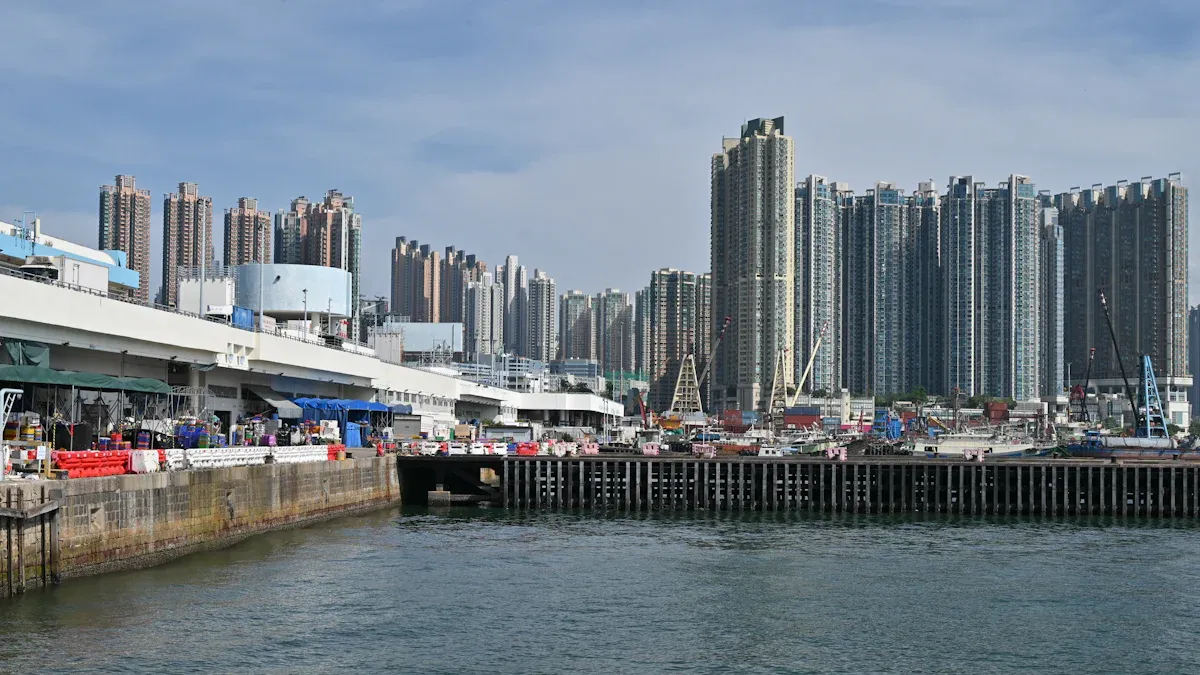
Urban Density and Informal Settlements
Urban density in the Philippines causes many fire risks. Homes in informal settlements are very close together. These places often use materials that catch fire easily. There is not much space for safe building. Many families share one electric meter. This can make wiring unsafe and cause short circuits. Streets are narrow, so firetrucks cannot reach fires fast. Without good fire zoning, fires spread quickly. Disaster risk management becomes harder.
-
Crowded areas, especially informal settlements, do not follow fire safety rules.
-
Informal settlements use materials that burn easily and have few building choices.
-
Unsafe and illegal electric connections make electrical fires more likely.
-
Narrow streets make it hard for firetrucks to help and stop disasters.
-
No proper fire zoning means fires spread fast and disaster risk reduction is tough.
Sitio Kislap in Quezon City shows how these problems get worse. The community grew from 50 to 600 families. Homes are packed close together. People use shared wiring and informal power sources. These things make fire hazards higher and disaster risk management harder. If you help upgrade informal settlements, you lower these risks. You support changes that make everyone safer and help disaster mitigation.
Tip: You can join programs to upgrade informal settlements and support safer building in the Philippines.
Policy and Regulatory Context
The Philippines has strong fire safety rules. Every business needs a Fire Safety Inspection Certificate (FSIC). The Bureau of Fire Protection checks these rules and does yearly inspections. Tall buildings must have fire sprinkler systems. You need an FSIC to get or renew a business permit. Inspectors look at building design, fire alarms, fire suppression, emergency exits, and safety equipment. The FSIC lasts one year and must be renewed.
-
The FSIC makes sure places follow fire prevention and disaster mitigation rules.
-
Yearly inspections keep places safe and help disaster risk reduction.
-
To get an FSIC, you send documents, have inspections, fix problems, and pay fees.
-
Rules cover all places, but there are no special rules for urban renewal areas.
-
Upgrading informal settlements needs better policies for disaster risk management and disaster mitigation.
Strengthening fire safety policies in the Philippines can enhance disaster risk reduction and management, support the upgrading of informal settlements, and promote more effective disaster mitigation, ultimately making communities safer.
Challenges in Informal Settlement Upgrading
Infrastructure and Resource Gaps
There are many problems in informal settlements in the Philippines. These places often do not have legal status. Houses are very close together and use plywood and plastic. Water and safe electricity are missing or not reliable. This makes disaster risk reduction very hard. Fire trucks cannot get through narrow paths and blocked alleys. People have trouble leaving quickly during a fire. Fire safety codes are not followed. Many people use unsafe wires and open flames for cooking and light. These things make fires more likely and disaster mitigation harder.
-
Houses are close together and use materials that burn fast.
-
Water and electricity are not always safe or easy to get.
-
There are no real fire safety rules or people to check them.
-
Many people do not know about fire risks or safe ways to act.
-
Residents and local authorities do not coordinate on fire safety.
-
Not enough resources make it hard to build new roads or firebreaks.
-
Unsafe wires and open flames are everywhere.
-
Fires spread fast, and people rebuild with the same risky stuff.
Upgrading informal settlements in the Philippines needs more than new houses. Disaster risk reduction and disaster mitigation must be part of every step. When you help with planning and teach the community, you help real change happen.
Note: To upgrade informal settlements in the Philippines, you must fix both the physical problems and disaster risk reduction needs.
Land Tenure and Community Engagement
Land tenure insecurity is another big problem in the Philippines. Many people in informal settlements do not own their land. This makes it hard to join fire safety projects. If you do not feel safe, you may not want to help with disaster risk reduction. You might worry about losing your home if you join upgrading projects.
-
People do not want to help with fire safety if they do not own land.
-
Confusing land claims and unclear owners make people scared and slow to change.
-
Some people do not trust new projects or may even break new things.
-
When people own their land, they want to help with fire safety and upgrading.
You can help by supporting planning and making land rights clear. This helps people trust the process and join disaster mitigation. When everyone in the Philippines is included in upgrading, you make real change. Communities become safer and stronger.
Integrated Fire Safety Solutions by TYEE
Emergency Lighting and Evacuation Systems
You can help keep people safe from fire in the Philippines by using emergency lighting and evacuation systems. These systems help everyone leave quickly when there is a fire. Many buildings in the Philippines have small hallways and exits. Bright lights and clear signs show people where to go. Tyee’s emergency lights work even if the power goes out. The lights stay on for 90 minutes, so people have time to get out.
Exit signs from tyee change if a fire blocks a path. The signs show new arrows and directions to help you escape. Voice evacuation systems tell you what to do and where to go. This helps people stay calm and move fast, even in busy places like malls or apartments.
Tyee’s systems use smart technology. They connect to fire alarms and building controls. When a fire alarm sounds, the lights turn on and doors unlock. You get quick alerts and bright signs. The system works well in places with lots of people, old wiring, or wet air. These problems are common in many parts of the Philippines.
Tip: Practice fire drills with real emergency lights. This helps you learn the best way out and fix problems before a real fire.
Here are some things you get with Tyee’s emergency lighting and evacuation systems in the Philippines:
-
They work when the power goes out
-
Exit signs change if fire blocks a path
-
Voice instructions help you leave safely
-
They connect to alarms and building controls
-
You get updates and can check the system from far away
-
They work in crowded and tricky buildings
You see these systems in malls, factories, subways, and airports in the Philippines. They help people get out faster and safer.
Smart Fire Alarm and Detection Systems
You can help protect communities with smart fire alarm and detection systems from TYEE. These systems use advanced sensors to detect fires early. Alerts are sent to phones, computers, or screens in about 5 seconds, faster than traditional alert methods, so people can act quickly and evacuate safely.
TYEE smart alarms reduce false alerts. Sensors distinguish real fires from harmless smoke, so you get accurate warnings without wasting time. The system can also integrate with emergency responders, sending maps and danger zone information to help teams respond faster.
These systems are suitable for busy public spaces. Alarms can trigger emergency lights, unlock doors, and follow automatic evacuation plans. Managers can monitor and control the system remotely, getting live data and addressing issues before they escalate.
Here is a table that shows how Tyee’s fire safety solutions help you respond quickly in any community:
|
Metric |
How It Helps You in the Philippines |
|---|---|
|
Average alert activation time |
Alerts happen in about 5.3 seconds, so help arrives quickly. |
|
Consistency of activation times |
Alerts stay steady, with only 0.8 seconds difference.making the system reliable. |
|
Faster acknowledgment of alerts |
Alerts are acknowledged 85% faster than traditionalradios or PA systems, enabling quick action. |
|
Staff response speed |
Staff can respond up to 4 times faster, helping morepeople in less time. |
|
On-site response improvement |
Direct notifications improve on-site response speedby 31%, so help arrives sooner. |
|
Real-world rapid response example |
In tested environments, deputies or staff can arrivewithin seconds after an app alert. |
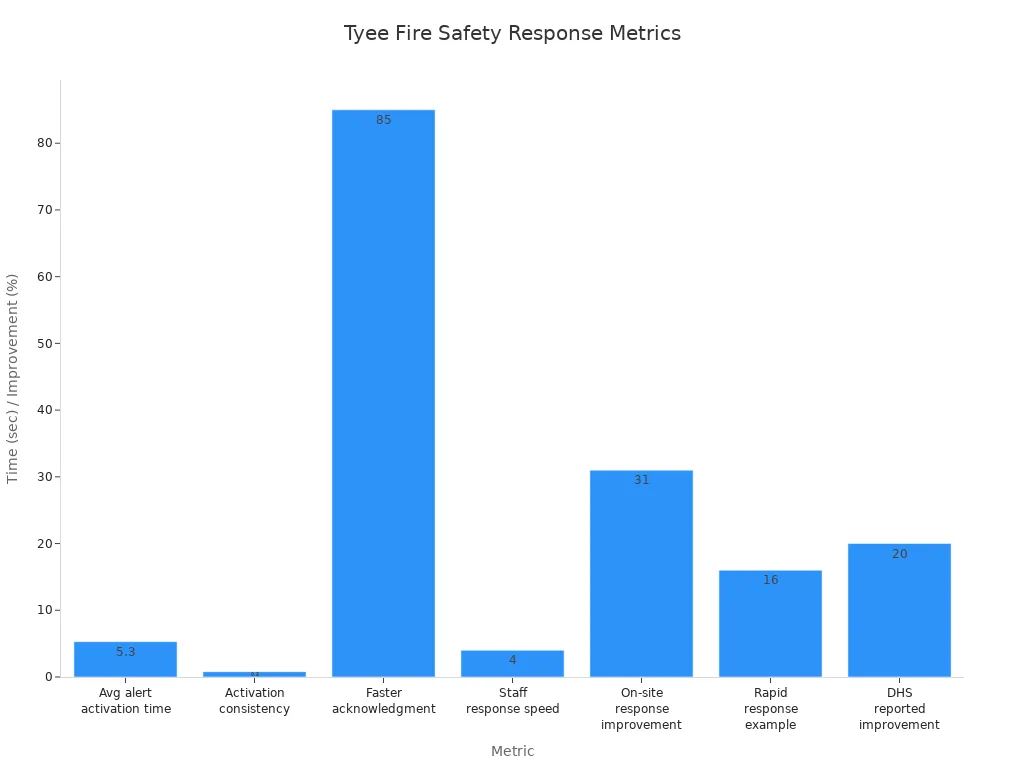
You can use Tyee’s fire alarm systems in homes, schools, offices, and shops, including urban areas in the Philippines. The TY223 Combustible Gas Alarm System detects gas leaks quickly. Smart smoke detection systems provide accurate alerts. You can also upgrade older fire alarms to comply with local fire safety regulations. Early detection helps address hidden hazards such as outdated wiring, gas leaks, and blocked exits.
Here is a list of Tyee’s fire safety products suitable for urban renewal areas:
-
Certified OEM/ODM fire alarm solutions for local businesses
-
TY223 Combustible Gas Alarm System with dual-sensor detection
-
Smoke Detection and Alarm System with smart sensors
-
Fire alarm system upgrade solutions for safety code compliance
-
Emergency Lights (Stand Alone, CBS, CMS)
-
Domestic Alarms, including Wireless Fire Alarms
-
Commercial Fire Alarm Systems (Addressable and Conventional)
With these systems, you get live monitoring and fast alerts. IoT sensors and smart detection work together to keep people safe. The cloud platform lets you control everything in one place, see unsafe spots, plan repairs, and respond to emergencies faster. These solutions can help communities in the Philippines become safer and more fire-resilient.
Note: Using Tyee’s smart fire safety systems can help protect lives and property in the Philippines, contributing to safer communities.
Community-Driven Fire Safety Initiatives
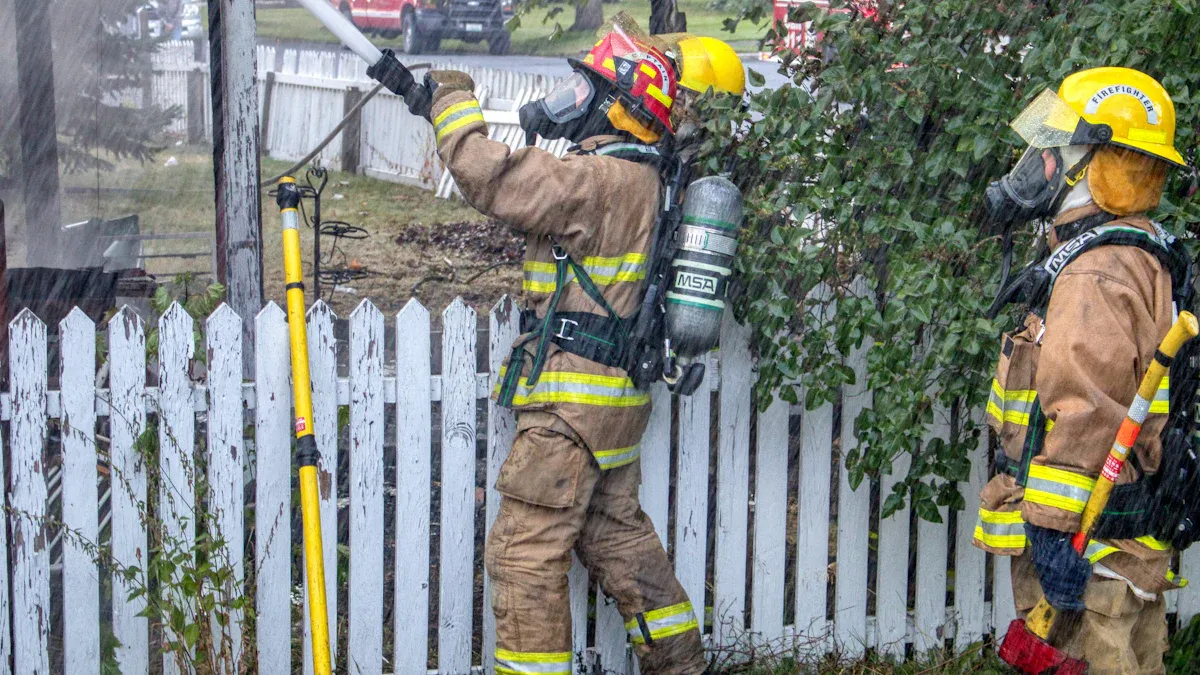
Local Training and Awareness
You help keep your neighborhood safe in the Philippines. When you join fire safety training, you learn to spot dangers. You also learn how to act quickly. Workshops and safety events let you practice what to do in a fire. You can join drills that show safe ways to leave your home. These activities help everyone trust each other and feel ready.
Many communities use apps and websites to report fire hazards. You can use your phone to tell about blocked exits or broken alarms. Local safety groups meet to talk about problems and share tips. When you join these groups, you help your neighbors stay safe. This is called community-based disaster preparedness. It means everyone works together before a disaster happens.
Tip: Practice fire drills with your family and friends. Knowing what to do can save lives.
Stakeholder Collaboration
You cannot make fire-resilient communities by yourself in the Philippines. You need to work as a team. Property managers, residents, urban planners, and fire teams must work together. When you join meetings with these groups, you help make better plans. You can share ideas and learn from others.
Here are some ways you can help:
-
Work with property managers to check fire exits and alarms.
-
Talk to urban planners about safer building designs.
-
Join meetings with fire, health, and housing teams.
-
Support upgrades like new sprinkler systems and wireless alarms.
-
Use smart technology, such as IoT sensors and cloud platforms, for early fire detection.
When you join these efforts, you help your community grow stronger. You help make rules clear and include everyone in the process. Real-life examples in the Philippines show that teamwork and good plans lower fire risks. You see safer buildings and stronger communities.
|
Who Should Work Together? |
What Can They Do? |
|---|---|
|
Residents |
Report hazards and join safety drills |
|
Property Managers |
Maintain alarms and exits |
|
Urban Planners |
Design safer spaces |
|
Fire Teams |
Lead training and respond to fires |
You help make the Philippines safer when you join these activities. Every action matters.
Case Studies and Success Stories
Manila Urban Renewal Projects
Smart fire alarms and emergency lights are being introduced in urban renewal areas in Manila. These upgrades help people evacuate buildings quickly and safely during fires. Adaptive signage can indicate blocked hallways, and voice alarms provide clear instructions during emergencies. These improvements can help families in crowded areas stay safer.
Local programs aim to teach residents about fire safety. Drills show how to use alarms and report hazards, helping more people understand what to do if a fire starts. By participating in these programs, communities can enhance safety. These initiatives demonstrate how teamwork and smart tools can reduce fire risks in the Philippines.
Tyee’s International Experience
You can learn from Tyee’s work in other countries. In Africa, Tyee worked with local partners to install fire alarms and evacuation systems. Products were adapted to local regulations and underwent rigorous testing, helping people trust the new systems. Smart tools like IoT and AI were used to detect fires early and send rapid alerts. Clear alarms and integrated systems improve emergency response and awareness.
Here are some lessons from Tyee’s work in other places:
-
Adapt fire safety products to local needs and regulations.
-
Use strong certifications to build trust in the products.
-
Integrate smart technology for improved fire detection.
-
Ensure alarms and alerts are easy to understand.
-
Keep systems updated to address new risks.
-
Collaborate with local teams for better results.
-
Plan and practice for emergencies.
These lessons can be applied in the Philippines. By selecting suitable systems and working together, communities can enhance safety. Tyee’s experience shows that smart planning and teamwork can make communities safer beyond the Philippines.
Benefits and Ongoing Adaptation
Enhanced Safety and Resilience
When you help with fire safety upgrades, your community gets safer. These upgrades do more than just stop fires. They also help your neighborhood get ready for climate change adaptation. Using smart alarms, emergency lights, and clear escape routes helps everyone leave safely. These things protect homes and schools from future risks.
Climate change adaptation means getting ready for new dangers. Hotter days and stronger storms can make fires worse. If you plan for these changes, you keep your family and neighbors safe. You also help your city recover faster after a fire. Good fire safety systems lower the chance of big losses. They help everyone get back to normal life more quickly.
Note: Joining fire drills and learning about safety builds trust and teamwork in your community.
Here is a quick look at how fire safety upgrades help with climate change adaptation:
|
Benefit |
How It Helps You |
|---|---|
|
Early fire detection |
Stops fires before they spread |
|
Smart evacuation systems |
Guides people to safety quickly |
|
Community training |
Prepares everyone for emergencies |
|
Stronger buildings |
Protects against fire and bad weather |
Continuous Improvement
You keep your community strong by always trying to get better. Continuous improvement means you do not stop after one upgrade. You check fire safety systems often. You talk with neighbors and leaders about what works and what needs to change. This helps everyone stay ready for new risks.
Cities like Xi’an show that ongoing adaptation works best when you use local knowledge and new technology together. You learn from each fire drill and update your plans. You listen to experts and share ideas with other communities. This process helps you get better at climate change adaptation every year.
You can:
-
Join meetings to talk about fire safety.
-
Share what you learn with friends and family.
-
Help test alarms and escape routes.
-
Suggest new ideas to local leaders.
When you work together, you help your community stay safe now and later. You also help your city become a good example for climate change adaptation and fire resilience.
By working together, communities in Manila can not only reduce fire risks today but also build lasting resilience for the future. With smart technology, clear safety standards, and active resident participation, people can evacuate safely and neighborhoods remain protected. Communities can collaborate with local leaders, NGOs, and technology providers, and by maintaining regular training and feedback, make fire safety a part of daily life. Through these combined efforts, communities become safer, stronger, and more resilient, while also serving as a model for other cities in the Philippines.
FAQ
What makes a community fire-resilient?
A fire-resilient community uses smart alarms, clear escape routes, and strong building rules. You join drills, learn safety steps, and work with neighbors. These actions help you spot dangers early and leave safely during a fire.
How do smart fire safety systems help you?
Smart fire safety systems alert you fast when they detect smoke, heat, or gas. You get warnings on your phone or hear alarms. These systems help you act quickly and guide you to safe exits.
Can you upgrade old buildings with new fire safety technology?
Yes, you can add smart alarms, emergency lights, and clear signs to old buildings. These upgrades help you meet safety codes and protect everyone, even in older homes or apartments.
Who should join fire safety programs in your area?
Everyone should join. You, your family, neighbors, property managers, and local leaders all play a part. When you work together, you make your community safer and stronger.

